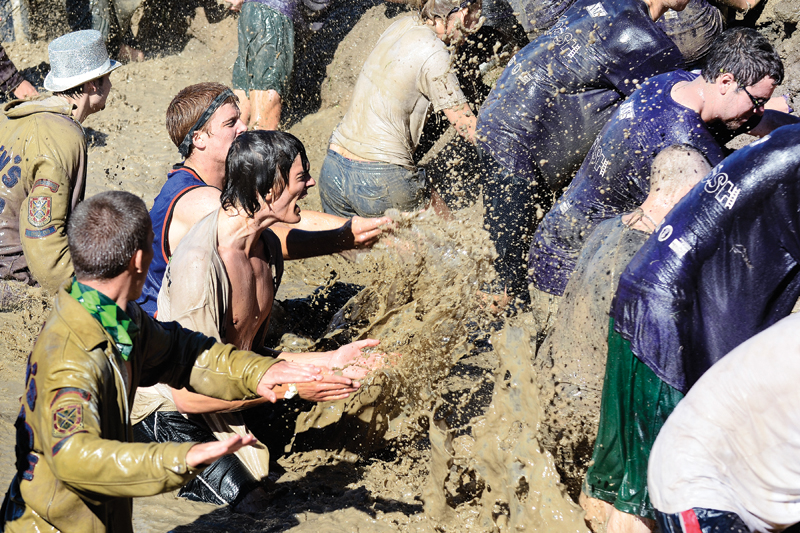
Evolving safety concerns with the annual Grease Pole have meant changes in the logistics of the event.
“No specific safety concern increased, our definition of safety has just changed,” said Ross Chaudhry, director of professional development for the Engineering Society (EngSoc).
As of last year, the event is limited to those in the Faculty of Engineering and Applied Science. Upper-year students must go through mandatory training if they want to attend.
“We were restricting the number of people that could come to the Grease Pole as a whole,” Chaudhry, Sci ’12, said.
Limiting attendance was a collective safety decision made in meetings with Queen’s administration and EngSoc.
“If that means we can continue having the Grease Pole next year then that’s a decision I support,” he said.
Despite size limitations, alumni continue to return to the event each year.
“I’m sure we would see less alumni donations if we stopped running the pole,” Chaudhry said, adding that such a loss couldn’t be quantified.
A logistical change this year was that students did not have the option to drive themselves to the off-campus site. “Giving out parking passes, giving people instructions to the pole site and organizing parking at the location was very difficult,” he said. “We don’t have a parking lot and the land itself is uneven.”
The event has evolved since it first began in 1956 but has remained an important part of the Engineering Frosh Week, Chaudhry said.
“[The Grease Pole] is one of the things that the Engineering Society is fighting the hardest for,” he said.“The unity of the Engineering faculty as a whole is solidified at the Grease Pole.”
The last serious injury at the event occurred in 2008 when a Sci ’12 student was treated in an ambulance for dehydration.
“It inherently can be a dangerous event, but it’s been planned really well,” Chaudhry said, adding that the most common injuries are scrapes, mud in ears and shortness of breath. All of these issues can be treated by Queen’s First Aid (QFA) members on site. Student Constables, QFA Lifeguards, experienced engineering students that make up the Water Team, Kingston Police and two ambulances are also on site.
Any Queen’s affiliated organizations at the event receive Grease Pole training sessions prior to the event.
During the Highland Games, a frosh event traditionally held the day before Grease Pole, first-year Engineering students attend a session where they learn what the event is and how to climb the pole.
“Frosh alone can’t climb it,” Chaudhry said. “After a certain amount of time, which varies from year to year, they let the upper-years in. And they let the upper-years in year by year.”
The shorter the climb time the safer the event is, Chaudhry said, adding that there have been discussions about the amount of time Frosh should be alone in the pit.
“We don’t want the pole climb to take too long,” he said. “As people get more fatigued there’s a higher chance of injury.”
Since the implemented changes, not only has the event become safer than in previous years but climb times have dropped.
On Sept. 10, the Applied Science and Engineering class of 2015 took two hours, nine minutes and six seconds to climb to the top of the pole and secure the tam. They beat last year’s record of two hours, 18 minutes and 29 seconds.
After climbing over three tiers of students, Mike Powell, Sci ’15, pulled down the tam on his first attempt.
Weighing 145 lbs with a height of 6’5, Powell said he was approached to be Tam Frosh during training.
“Of course I said yes because it’s a great honour,” he said. “I didn’t really do much, it was mostly the people below me holding me up. I stood on their faces a bit.”
Pole points
The pole is hand-greased with lanolin. It’s ingestible and very difficult to remove.
The tam is nailed down onto the top of the pole.
The current classified location of the event is reasonably permanent as far as the Engineering Society is concerned, said Ross Chaudry, EngSoc director of professional development. The field is owned and insured by Queen’s.
Calling ‘break’ is one of the main safety features at the event. Once the word is yelled, the climb must stop as it means someone in the pit needs a rest or assistance.
If participants or spectators need a break, there are two school busses on site designated as warming buses.
Students may only climb the pole if there’s an ambulance present. With two on site, the climb may continue if one is needed to drive a participant to a hospital.
The climb
Approximately 10 rings of students link arms around the base of the pole.
Outer students push against these rings directly towards the pole. If they push off center, the rings will twist and break.
The next two tiers are made by students who climb on top and link arms in rings.
The fourth level is the Tam Frosh, usually standing on last year’s Tam Frosh.
Tags
EngSoc, Frosh Week, Grease Pole, Tam Frosh
All final editorial decisions are made by the Editor(s)-in-Chief and/or the Managing Editor. Authors should not be contacted, targeted, or harassed under any circumstances. If you have any grievances with this article, please direct your comments to journal_editors@ams.queensu.ca.
